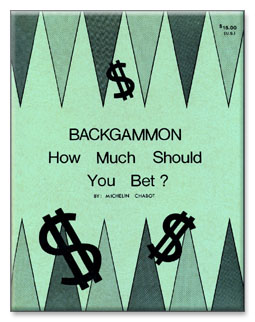
|
Backgammon Books

|
 |
|
|
|
| |
|
Backgammon
How Much Should You Bet?
|
| |
|
|

|
|
AUTHOR:
|
|
Michelin Chabot
|
|
YEAR:
|
|
1982
|
|
PUBLISHER:
|
|
Michelin Chabot
|
|
CITY:
|
|
Montreal, Quebec
|
|
ISBN:
|
|
0-9691012-0-1
|
|
BINDING:
|
|
Softcover, staple bound
|
|
PAGES:
|
|
ii+98
|
|
SIZE:
|
|
30 cm high, 22 cm wide
|
|
DOWNLOAD:
|
|
www.bkgm.com/books/Chabot/HowMuchShouldYouBet.pdf
|
|
DESCRIPTION:
|
|
| To make money in backgammon, you need two elements: (1) a skill advantage, and (2) good money management principles. Chabot explains money management for games in general and then goes on to show the adjustments needed for the game of backgammon. This means determining the proper size of your initial bet and handling the cube properly. |
|
READERS
COMMENTS:
|
|

| |
"I asked Danny Kleinman about applying the Kelly criterion to backgammon
in a letter to the Chicago Point in the January 1989 issue. Kleinman
wrote that Michelin Chabot had written two books applying Kelly theory to
backgammon, but Kleinman disparaged the books and didn't give any
references. Kleinman then admitted that he didn't know about the Kelly
criterion and went on to suggest 'stakes low enough to absorb a 200
point loss without emotional ruin.' This isn't horrible advice, but
with Kelly you can do much better."—David Montgomery, June 1999
|
|
|


| |
"At first glance this book appears too mathematical and impractical. Do not become intimidated by this. The early chapters create a foundation that the rest of the book builds on. I personally found chapter eight, "Money Management vs. the Doubling Cube," to be one of the most fascinating and relevant backgammon gambling theories that I have ever read. The book is worth twice its price for this section alone."—Kathy Posner, Backgammon Times, Fall 1982
|
|
|


| |
"In his book, Backgammon: How Much Should You Bet?, Michelin Chabot addresses two questions: the size of the stakes, and cube action. Citing formulas from Richard Epstein's The Theory of Gambling and Statistical Logic, Chabot develops principles for choosing the stakes. Chabot presupposed that you have a specific goal (e.g., winning $100) and a specific gambling capital you are willing to lose (e.g., $1000). Between these limits money is meaningless. Clearly there are very few real-life circumstances in which this is a rational set of values.
In discussing cube actions, Chabot introduces the goal of maximizing hourly expectation, which is reasonable. If you have a large positive equity in the next game, it is worth passing a marginally sound take in a game which could last a very long time. But Chabot misapplies this concept. He assumes that during the rest of the hour the player will continually have backgammon positions as favorable as this one to play from."—Danny Kleinman, "Help for the Hustler?" Double Sixes from the Bar, 1982.
|
|
|

|
|
CONTENTS:
|
|
| |
|
Acknowledgments
Forward
Introduction
Chapter 1. Calculation of the expectation, hourly expectation and single-trial probability of success
Chapter 2. Calculation of the probability of success
Chapter 3. Calculation of the probable number of games
Chapter 4. The suggested criteria for determining the appropriate bet for games in general
4.1. Criterion no. 1: Determination of the bet in terms of the maximization of the probability of success
4.2. Criterion no. 2: Determination of the bet in terms of the maximization of the hourly expectation
4.3. Criterion no. 3: Determination of the bet in terms of a pre-established probability of success (for favorable games)
4.4. Criterion no. 4: Determination of the bet in terms of pre-established number of games
Chapter 5. Complete strategy for games in general
Chapter 6. Suggested adjustments for backgammon
6.1. Adjustment I: Percentage of a long-term bankroll which can be risked in a session
6.2. Adjustment II: Number of games to be played
6.3. Adjustment III: Regulations concerning the doubling cube
6.4. Adjustment IV: Number of possible opponents
6.5. Playing matches
Chapter 7. Complete strategy suggested for backgammon
7.1. Evaluation of the maximum bet
7.2. Evaluation of the single-trial probability of success
7.3. Choice of criterion to use
7.4. The "hourly expectation formula" applied to backgammon
Chapter 8. Money management versus the doubling cube theory
Chapter 9. Principles of money management in practice
Conclusion
|
|
|
ABOUT THE
AUTHOR:
|
|
Michelin Chabot graduated from Sherbrooke University in the Province of Quebec (Canada) as a civil engineer in 1972. He played chess seriously from 1964 to 1976, but gave it up to devote himself entirely to backgammon.
His first publication, Backgammon: How Much Should You Bet?, is the only comprehensive guide to establishing an appropriate bet. The theories are interspersed with clear, practical examples to illustrate the principles of wise money management. The book breaks new ground, and is therefore a much needed, long awaited manual in the world of backgammon.
|
BY THE SAME
AUTHOR:
|
|
 | |
Backgammon
How to Maximize Your Profits and Optimize Your Cube Decisions Using the Kelly System
Michelin Chabot
1983: Michelin Chabot, Montreal, Quebec
|
|
|
 |
|















